Oral
Safety: That Implant Is Hot!
ISMRM & SMRT Annual Meeting • 15-20 May 2021

| Concurrent 4 | 16:00 - 18:00 | Moderators: Kelvin Chow & Ozlem Ipek |
 |
0357.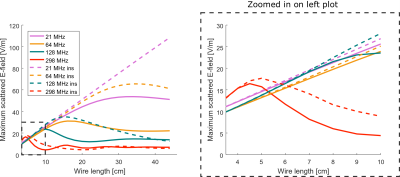 |
Effect of transmit frequency on RF heating of metallic implants
Bart R. Steensma1, Janot P. Tokaya2, Peter R. S. Stijnman1, M. Arcan Erturk3, Cornelis A. T. van den Berg1, and Alexander J. E. Raaijmakers4
1Center for Image Sciences - Computational Imaging Group, University Medical Center Utrecht, Utrecht, Netherlands, 2TNO, Utrecht, Netherlands, 3Medtronic, Minneapolis, MN, United States, 4Biomedical Engineering - Medical Imaging Analysis, Eindhoven University of Technology, Eindhoven, Netherlands
The effect of transmit frequency on the risk of RF heating for elongated metallic implants was investigated through simulations in a phantom and a human model for 21, 64, 128 and 300 MHz. We demonstrate that for uniform E-field exposure, worst-case E-field enhancement at the tip reduces with increasing transmit frequency. However, for realistic E-field exposures, E-field enhancement increases with transmit frequency for similar B1+ levels. For similar head SAR levels, E-field enhancement for worst-case implant length is roughly equal for all transmit frequencies. In all cases implant length is the main determinant of RF heating.
|
|
 |
0358.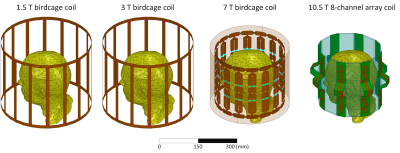 |
Demystifying the effect of field strength on RF heating of conductive leads: A simulation study of SAR in DBS lead models during MRI at 1.5 T - 10.5 T
Ehsan Kazemivalipour1,2,3, Alireza Sadeghi-Tarakameh4, Boris Keil5, Yiğitcan Eryaman4, Ergin Atalar1,2, and Laleh Golestanirad3,6
1Electrical and Electronics Engineering Department, Bilkent University, Ankara, Turkey, 2National Magnetic Resonance Research Center (UMRAM), Bilkent University, Ankara, Turkey, 3Department of Radiology, Feinberg School of Medicine, Northwestern University, Chicago, IL, United States, 4Center for Magnetic Resonance Research (CMRR), University of Minnesota, Minneapolis, MN, United States, 5Institute of Medical Physics and Radiation Protection, Mittelhessen University of Applied Sciences, Giessen, Germany, 6Department of Biomedical Engineering, McCormick School of Engineering, Northwestern University, Evanston, IL, United States
We examined the effect of magnetic field strength, and by proxy RF resonance frequency, on RF heating of deep brain stimulation (DBS) lead models during RF exposure covering frequencies from 64MHz (1.5T) to 447MHz (10.5T). We report 1g-SAR at the tips of a cohort of 33 DBS implant models with realistic trajectories when the input power of RF coils was adjusted to impose safety limits based on either B1+ or global head SAR. We observed that coils with higher resonance frequency generated a lower 1g-SAR around implanted leads when the global head SAR was kept constant across different coils.
|
|
0359.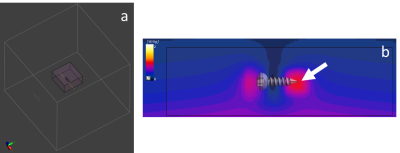 |
An Investigation of SAR Values Induced Near an Orthopedic Implant at 7T Relative to Lower Fields: A Simulation Study
Paul S Jacobs1 and Andrew J Fagan1
1Radiology, Mayo Clinic, Rochester, MN, United States
Electromagnetic simulations were performed to investigate the maximum local 1g-averaged SAR induced in tissue adjacent to orthopedic screws of varying lengths across field strengths ranging from 3T to 7T. Simulated input power values were initially normalized to a constant transmitted power of 1W and further normalized to ensure a constant background B1+ value. SARmax was approximately 36% lower than the peak near 4T. The results demonstrate that RF-induced tissue heating near implants can, in certain circumstances, be lower at higher fields.
|
||
0360.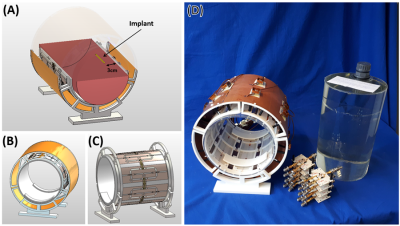 |
Safe 7T MRI of tissues neighboring Mg-based biodegradable implants using parallel transmission
Mostafa Berangi1,2, Andre Kuehne1, and Thoralf Niendorf1,2
1MRI.TOOLS GmbH, Berlin, Germany, 2Berlin Ultrahigh Field Facility (B.U.F.F.), Max Delbrück Center for Molecular Medicine in the Helmholtz Association, Berlin, Germany
Bio-degradable implants have the benefit of eliminating implant removal surgery. Yet, it’s essential to monitor the implant and tissue\bone after implementation. MRI monitoring in the vicinity of the implant might be compromised by tissue heating and transmission field inhomogeneities. To address these challenges here an RF transceiver array is designed, manufactured and evaluated aiming to facilitate 7T MRI in the vicinity of implants. For this purpose, EMF simulations are performed to derive an optimum excitation vector that reduces local RF power deposition while ensuring a proper B1+-field. The RF array is evaluated in phantom experiments and benchmarked with the simulations.
|
||
0361.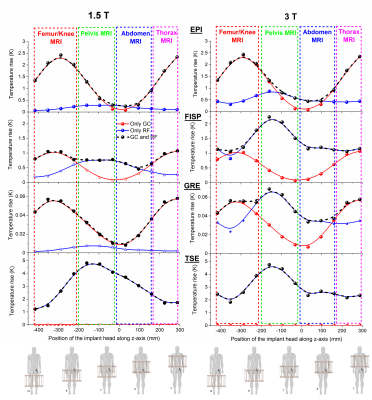 |
Combined heating of hip joint implant by radiofrequency and switched-gradient fields during MRI examination
Alessandro Arduino1, Umberto Zanovello1, Jeff Hand2, Luca Zilberti1, Rüdiger Brühl3, Mario Chiampi1, and Oriano Bottauscio1
1Istituto Nazionale di Ricerca Metrologica, Torino, Italy, 2School of Biomedical Engineering and Imaging Sciences, King’s College London, London, United Kingdom, 3Physikalisch-Technische Bundesanstalt, Braunschweig and Berlin, Germany
Local heating effects in patients carrying orthopaedic implants have been studied mostly as a consequence of radiofrequency fields and, to a less extent, to gradient coil fields, separately. In this study the heating produced by the combined effects of both fields during realistic clinical sequences is numerically simulated in an anatomical human model carrying a CoCrMo hip implant. Risky situations have been identified, also showing that, sometimes, the gradient field heating can be most significant. The analysis suggests that criteria, based on whole-body SAR only, may not be sufficient to ensure patients’ safety.
|
||
 |
0362.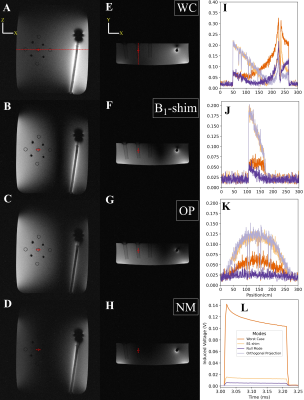 |
Safe scanning of elongated implants with the sensor matrix QS: Comparison of orthogonal projection and null mode based pTx mitigation
Berk Silemek1, Frank Seifert1, Bernd Ittermann1, and Lukas Winter1
1Physikalisch-Technische Bundesanstalt (PTB) Braunschweig and Berlin, Berlin, Germany
The sensor Q Matrix ($$$Q_S$$$) concept is introduced for safe MRI of elongated implants without compromising imaging quality. For this purpose, small and low-cost sensors, parallel transmission (pTx) and the orthogonal projection method are sufficient without the need to perform simulations, safety testing or additional MR imaging. The $$$Q_S$$$ can also be implemented along with other pTx mitigation methods such as null modes. The $$$Q_S$$$ based orthogonal projection method and the null modes method are demonstrated in testbed and MRI experiments.
|
|
0363.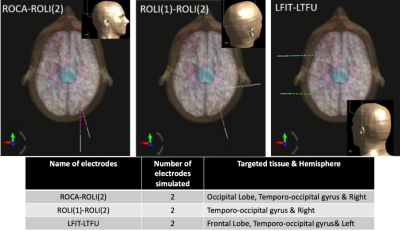 |
Safe-MRI with stereo-electroencephalography (sEEG) for epilepsy patients
Flora Guarnotta1, Jeremie Clement1, Rachel Sparks1, and Özlem Ipek1
1School of Biomedical Engineering and Imaging Sciences, King's College London, London, United Kingdom
Epileptic seizure investigations with sEEG electrodes are limited to regions sampled and this may exclude relevant seizure network areas. Simultaneous EEG/fMRI may better elucidate the relationship whole-brain interactions and sEEG connectivity. However, excessive radiofrequency(RF) heating of implanted electrodes is showstopper. We investigated the role of parallel-transmit(pTx) RF coil arrays at 3 Tesla to control the RF-heating and local signal increases near the electrodes using computational field simulations. The pTx coils more specifically the 16ch was more efficient than the birdcage in terms of controlling the RF-field steering in the brain, which indicated less RF-heating near the contacts of the electrodes.
|
||
 |
0364.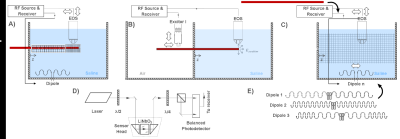 |
MR Safety Assessments of Active Implantable and Interventional Devices in a Single Measurement Setup
Ali Caglar Özen1,2, Simon Reiss1, Thomas Lottner1, Dursun Korel Yildirim3,4, Ozgur Kocaturk3,5, and Michael Bock1
1Deptartment of Radiology, Medical Physics, University Medical Center Freiburg, University of Freiburg, Freiburg, Germany, 2German Consortium for Translational Cancer Research Partner Site Freiburg, German Cancer Research Center (DKFZ), Heidelberg, Germany, 3Institute of Biomedical Engineering, Bogazici University, Istanbul, Turkey, 4Cardiovascular Branch, Division of Intramural Research, National Heart Lung and Blood Institute, National Institutes of Health, Bethesda, MD, United States, 5Transmural Systems, Andover, MA, United States Interventional devices such as actively visualized catheters or guidewires have a long conductive line between the source and the probe at the tip. Long conductive wires can interract with the electromagnetic fields generated by the transmit coils resulting in RF-induced heating of surrounding tissue. Existing standards do not cover partial immersion and dynamic motion of such devices. In this study, we propose an automated electric field detection and mapping system that is capable of performing hotspot detection, transfer function(TF) measurement and TF validation using different dipole antennae. RF-induced heating can be evaluated without moving the device, thus eliminating positioning errors. |
|
0365.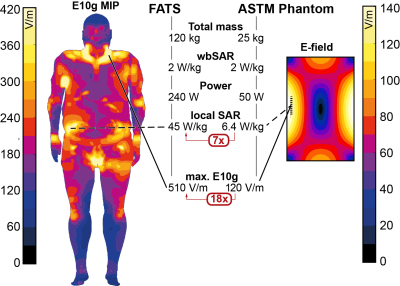 |
MRI Implant Safety: Method for RF Heating In-Vivo-Transfer Required from ASTM Standard F2182
Manuel Murbach1, Thomas Doering2, and Gregor Schaefers2,3
1Murbach EMConsulting, Zurich, Switzerland, 2MR:comp GmbH, Gelsenkirchen, Germany, 3MRI-STaR - Magnetic Resonance Institute for Safety, Technology and Research GmbH, Gelsenkirchen, Germany
This study aims at exploring an alternative method (Tier 2.5) to estimate realistic in vivo E-fields at implant locations by including the directivity and length of the implants, which neglects non-relevant E-field components and too localized averaging schemes. The latest revision of the ASTM standard F2182-19e2 requires establishing a relation of the temperature increase near a metallic implant between A) the experimental measurement and B) the in vivo estimation in a representative patient population. The usage of currently standardized methods results in presumably overly conservative estimations, causing implant labels to be up to a factor 10 more restrictive.
|
||
0366.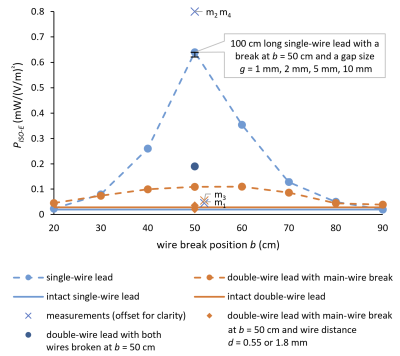 |
Radiofrequency-Induced Heating of Broken, Damaged, and Abandoned Leads
Aiping Yao1, Tolga Goren1, Theodoros Samaras2, Niels Kuster1,3, and Wolfgang Kainz4
1IT'IS Foundation, Zurich, Switzerland, 2Department of Physics, Aristotle University of Thessaloniki, Thessaloniki, Greece, 3ITET, ETH Zurich, Zurich, Switzerland, 4FDA, Silver Spring, MD, United States
To demonstrate the potential enhanced heating of abandoned (capped), damaged, or broken leads, we estimated in-vitro the deposited lead-tip power for a generic active implantable medical device (AIMD), intact and with wire breaks at regular intervals. We studied break size, a cut and capped lead, and a second wire parallel to the broken wire. The deposited lead-tip power enhancement was up to 30-fold over the intact lead. The presence of a nearby intact, or even broken, wire reduced this enhancement factor to ~3-fold. This shows the risk of extending MR-conditional labeling to broken, damaged, abandoned, or cut AIMD leads.
|
The International Society for Magnetic Resonance in Medicine is accredited by the Accreditation Council for Continuing Medical Education to provide continuing medical education for physicians.